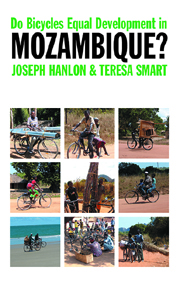Book contents
- Frontmatter
- Contents
- Acknowledgements
- The authors
- Money & measurements
- Abbreviations, acronyms & glossary
- Part I IS THERE DEVELOPMENT IN MOZAMBIQUE?
- 1 Introduction: more bicycles, but …
- 2 A brief history: war, peace & slow recovery
- 3 Can peasants pull Nampula out of poverty?
- 4 The Manica miracle is over
- 5 Cashew: from disaster to export model
- 6 Tobacco: hard choices
- 7 Has poverty decreased?
- 8 Is there development in Mozambique?
- Part II ACTORS & CONTEXT
- Part III ALTERNATIVES & THE DEVELOPMENTAL STATE
- Appendix 1 Aid
- Appendix 2 Investment & other tables
- Bibliography
- Index
1 - Introduction: more bicycles, but …
from Part I - IS THERE DEVELOPMENT IN MOZAMBIQUE?
Published online by Cambridge University Press: 05 April 2013
- Frontmatter
- Contents
- Acknowledgements
- The authors
- Money & measurements
- Abbreviations, acronyms & glossary
- Part I IS THERE DEVELOPMENT IN MOZAMBIQUE?
- 1 Introduction: more bicycles, but …
- 2 A brief history: war, peace & slow recovery
- 3 Can peasants pull Nampula out of poverty?
- 4 The Manica miracle is over
- 5 Cashew: from disaster to export model
- 6 Tobacco: hard choices
- 7 Has poverty decreased?
- 8 Is there development in Mozambique?
- Part II ACTORS & CONTEXT
- Part III ALTERNATIVES & THE DEVELOPMENTAL STATE
- Appendix 1 Aid
- Appendix 2 Investment & other tables
- Bibliography
- Index
Summary
Felito Julião is carrying two bundles of sugar cane on his bicycle. This bright young man earns a living with his bicycle, and has found a way to carry two bundles of cane instead of just one, like the others But the two bundles of tall cane are unstable and he has to walk slowly up the many hills. It takes more than half a day to travel the 23 km from Rapale to Nampula and, in practice, he has to travel with a friend who carries only one bundle, and who can help him if a bundle comes loose or help him back when they are forced off the narrow dusty road by a passing car. They earn 30 MT (£0.60, $1.20, €.86, R8.60) for each bundle. Thus the two men earn 90 MT for one and half days of work, roughly 30 MT per man per day to support their families.
Felito Julião is an example of the changes that have happened to Mozambique since the war ended in 1992. A rapid expansion of education means that he can read and write. He has a bicycle, which a decade ago was very uncommon. And he is bright and inventive, finding a way to carry more sugar cane and increase his income by a third; he now earns 30 MT for a day's work compared with the 20 MT he would be paid if he worked on a neighbour's field or carried just one bundle of cane. He is a Mozambican success story.
- Type
- Chapter
- Information
- Do Bicycles Equal Development in Mozambique? , pp. 1 - 5Publisher: Boydell & BrewerPrint publication year: 2008



